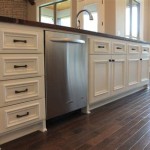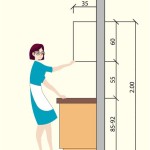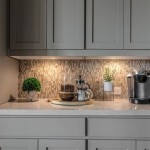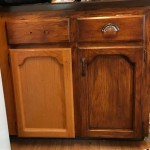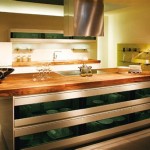High Ceiling Kitchen Cabinet Ideas: Maximizing Space and Style
High ceilings in a kitchen can create a dramatic and spacious feel. However, effectively utilizing the vertical space with kitchen cabinets requires careful planning and execution. Failing to address the upper reaches of the kitchen can leave valuable storage untapped and diminish the overall aesthetic appeal. This article explores several design ideas for high ceiling kitchen cabinets, aiming to provide comprehensive guidance for homeowners and designers seeking to optimize their kitchen spaces.
The advantages of high ceilings extend beyond mere aesthetics. They can improve ventilation, enhance natural light penetration, and create a sense of openness, making the kitchen a more comfortable and enjoyable space to work in. When combined with strategically designed cabinets, these benefits are amplified, resulting in a highly functional and visually appealing kitchen environment.
Extending Cabinets to the Ceiling: A Seamless Look
One of the most common and visually impactful approaches is to extend kitchen cabinets directly to the ceiling. This eliminates the awkward gap that often accumulates dust and debris. By creating a continuous vertical line, the cabinets contribute to a cleaner, more modern appearance. This design strategy also maximizes storage capacity, providing ample space for infrequently used items and seasonal cookware.
When opting for cabinets that reach the ceiling, consider the overall design style of the kitchen. For contemporary kitchens, sleek, minimalist cabinets with integrated hardware can create a clean and uncluttered look. In more traditional kitchens, cabinets with decorative moldings and classic hardware can add architectural interest. The key is to ensure the cabinet design complements the existing features of the kitchen, such as the countertops, backsplash, and flooring.
Material selection is also crucial. Painted cabinets are a popular choice, offering versatility and easy maintenance. Natural wood cabinets, such as maple, oak, or cherry, can add warmth and character to the kitchen. Glass-front cabinets, particularly in the upper reaches, can create a lighter and more airy feel, while also providing an opportunity to display decorative items or fine china. The choice of material should be informed by both aesthetic preferences and practical considerations, such as durability and ease of cleaning.
Furthermore, consider the accessibility of the upper cabinets. Given their height, it is essential to incorporate features that make them easily reachable. Pull-down shelves, integrated step stools, and strategically placed lighting can all enhance accessibility and usability. Planning for these features during the design phase will ensure that the upper cabinets are not just visually appealing but also functional and convenient.
Incorporating Transoms and Open Shelving
For those who prefer a less monolithic look, incorporating transoms above the cabinets can be an excellent option. Transoms are horizontal windows positioned above the cabinets, allowing natural light to filter through and creating a more open and airy feel. This design strategy is particularly effective in kitchens with limited natural light, as it helps to brighten the space and make it feel more inviting.
Alternatively, open shelving can be used in conjunction with or instead of traditional cabinets. Open shelving provides an opportunity to display decorative items, plants, or frequently used kitchenware, adding visual interest and personality to the space. However, it is important to maintain a sense of order and cleanliness, as exposed items can quickly become cluttered and detract from the overall aesthetic appeal.
When combining transoms and open shelving with traditional cabinets, careful attention must be paid to the proportions and balance of the design. The height of the transom windows should be proportional to the height of the cabinets, and the spacing between the shelves should be consistent and visually appealing. In addition, the materials and finishes of the transoms and shelves should complement the cabinets, creating a cohesive and harmonious design.
The placement of open shelving is also an important consideration. Open shelves are best suited for items that are frequently used and easily accessible. They should be positioned within easy reach, ideally at eye level or slightly above. Items that are infrequently used or purely decorative can be placed on higher shelves or in less accessible areas. This approach ensures that the open shelving is both functional and visually appealing.
Utilizing Crown Molding and Decorative Elements
Crown molding can be used to enhance the visual appeal of high ceiling kitchen cabinets, adding a touch of elegance and sophistication to the space. Crown molding is a decorative trim that is installed at the top of the cabinets, creating a seamless transition between the cabinets and the ceiling. It can be used to conceal any imperfections in the ceiling or cabinet installation, while also adding architectural interest and visual detail.
The style of the crown molding should be consistent with the overall design style of the kitchen. In traditional kitchens, ornate crown molding with intricate details can add a sense of grandeur and formality. In more contemporary kitchens, simple, clean-lined crown molding can create a more modern and understated look. The color of the crown molding should also complement the cabinets and other features of the kitchen, creating a cohesive and harmonious design.
In addition to crown molding, other decorative elements can be used to enhance the visual appeal of high ceiling kitchen cabinets. Decorative hardware, such as knobs and pulls, can add a touch of personality and style to the cabinets. Glass inserts in the cabinet doors can create a lighter and more airy feel, while also providing an opportunity to display decorative items. Lighting fixtures, such as under-cabinet lighting and pendant lights, can add warmth and ambiance to the space, while also highlighting the cabinets and other features of the kitchen.
Furthermore, consider the use of vertical panels or stiles to break up the monotony of long stretches of cabinets. These elements can add visual interest and create a sense of depth, making the cabinets appear less imposing. Vertical panels can be customized with different textures, colors, or patterns to complement the overall design style of the kitchen. The integration of these decorative elements can transform the cabinets from simple storage units into focal points of the kitchen design.
Beyond these key thematic points, practical considerations regarding the cost and installation process should be addressed. Extending cabinets to the ceiling can significantly impact the overall budget, as it requires more materials and labor. Obtaining multiple quotes from different contractors and carefully evaluating the estimated costs is essential. It is also important to consider the structural integrity of the walls and ceiling, as additional support may be needed to accommodate the weight of the extended cabinets. Consulting with a structural engineer or experienced contractor can help to identify any potential issues and ensure that the installation is done safely and correctly.
The choice of cabinet manufacturer or installer can also influence the quality and durability of the cabinets. Researching different options and selecting a reputable and experienced provider is crucial. Checking online reviews, requesting references, and visiting showrooms to see examples of their work can help to make an informed decision. A reputable provider will be able to offer a wide range of cabinet styles, materials, and finishes, as well as provide expert advice and guidance throughout the design and installation process.
Finally, consider the long-term maintenance and upkeep of the high ceiling kitchen cabinets. Dusting and cleaning the upper cabinets can be challenging due to their height. Investing in a good quality ladder or step stool, along with appropriate cleaning supplies, is essential. Regularly inspecting the cabinets for any signs of damage or wear and tear can help to prevent more serious problems from developing. By taking proper care of the cabinets, homeowners can ensure that they remain functional and visually appealing for many years to come.

Tall Ceiling Kitchen Cabinet Options Centsational Style

Kitchen Decor How To Make The Most Of A High Ceiling Design Layout Cabinet

Tall Ceiling Kitchen Cabinet Options Centsational Style

Tall Ceiling Kitchen Cabinet Options Centsational Style

Tall Ceiling Kitchen Cabinet Options Centsational Style

Kitchen Decor How To Make The Most Of A High Ceiling With Ceilings Cabinet Design Above Cabinets

Tall Ceiling Kitchen Cabinet Options Centsational Style

Kitchen Tall Ceilings Design Ideas

19 Vaulted Ceiling Kitchen Designs To Spark Your Imagination

32 Kitchens With High Ceilings Photos
Related Posts

